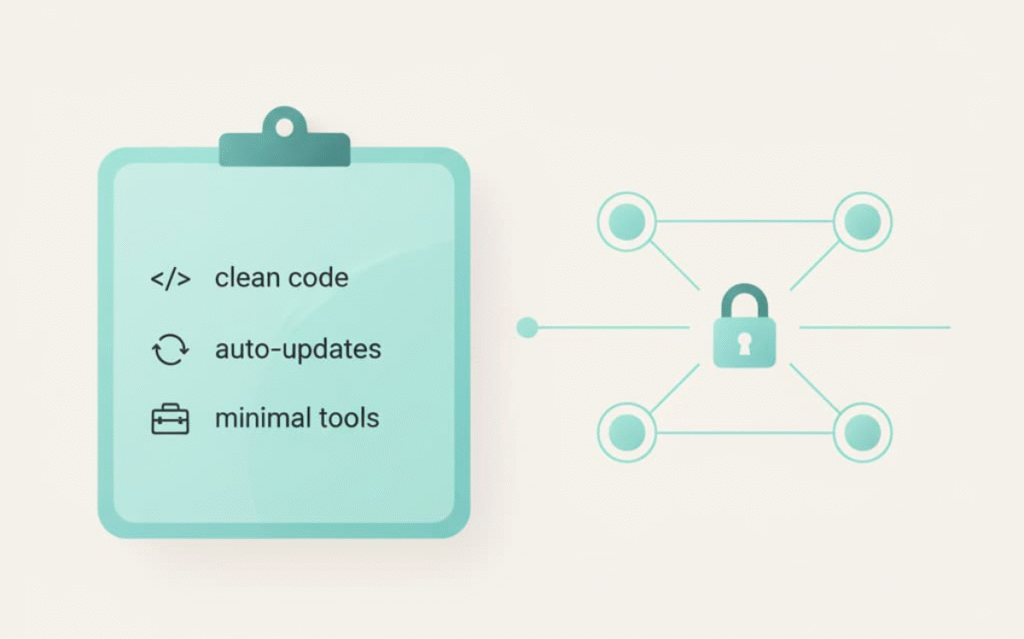
Drop the complexity, that’s what smart security is about. The KISS approach (Keep It Simple Security) cuts through the tech jargon and gets real. Most breaches happen because someone couldn’t handle their company’s maze of security protocols.
Nobody needs five different passwords and three authentication apps just to check their email. Pick simple, solid measures that work, like using a strong password manager or setting up basic two-factor auth. Wondering how simple security can actually stop hackers? Stick around.
Key Takeaways
- Simple security design reduces human error and eases threat detection.
- Minimal, clear controls improve manageability and user compliance.
- Efficient resource use supports critical security operations without bloat.
What is the KISS Principle in Cybersecurity?

Security doesn’t need to be a maze. KISS (Keep It Simple Security) strips away the fluff and focuses on what works. From our years training developers, we’ve seen how overly complex systems lead to costly mistakes – misconfigurations remain one of the top reasons companies get breached. This is why the importance of simplicity in security cannot be overstated. Simplifying security reduces risk and improves overall defense.
Small businesses and startups can’t waste time figuring out complicated security setups. When budgets are tight, simple but effective measures make the most sense. Throughout our bootcamps, students learn to spot unnecessary security layers that drain resources without adding protection.
Finding the sweet spot between protection and practicality takes experience. The goal isn’t to water down security, it’s creating protocols people actually follow. Our training emphasizes clear security rules that make sense to both developers and end users. After all, the best security system is one that teams can confidently manage day after day.
Key Aspects of the KISS Security Principle
Security Design Simplicity

Nobody likes dealing with overly complex security measures. Our bootcamp students often share stories of their teams bypassing complicated controls just to get work done. Simple, clear-cut security workflows just make more sense, they’re easier to follow and harder to mess up.[1]
Key benefits we’ve seen:
- Less chance of configuration mistakes
- Faster threat detection when things go wrong
- Teams actually stick to security practices
Take secure coding, we teach developers to write clean, straightforward code that’s easy to review and fix. Over the years, this approach has proven to cut down on bugs and security holes better than fancy, complicated solutions.
Efficient Resource Use
Throwing money at security doesn’t guarantee protection. Smart organizations (including many of our graduates) opt for streamlined solutions like cloud security tools instead of expensive on-site hardware. This lets them:
- Put resources where they count most
- Cut down on maintenance headaches
- Plug into existing systems smoothly
Small teams especially benefit from keeping things simple. Our training shows how basic security measures, done right, often protect better than complex systems.
Manageability
Simple security setups don’t give teams migraines. Through our courses, developers learn to build systems that stay current without constant babysitting. Good automation helps catch problems early, while clear architecture makes updates painless.
Benefits we’ve observed:
- Quick updates when threats emerge
- Smoother security audits
- Less operational overhead
Students tell us their teams love automated security checks, they catch problems before they grow into disasters.
System Architecture
Credits: IBM Technology
Fancy security architecture often creates more problems than it solves. Zero-trust models work because they stick to basics: verify everything, trust nothing. Our hands-on labs show why simpler network setups with clear access rules usually work better than elaborate schemes. This reinforces the idea that complexity is the enemy of security, and trimming down excess layers closes off common attack vectors.
This approach:
- Reduces weak spots hackers can target
- Makes security easier to implement
- Keeps policies consistent
Most environments don’t need complex network segmentation, basic role-based controls usually do the job.
Usability
Security measures fail when users can’t figure them out. During training, we emphasize practical solutions like sensible password rules instead of impossible requirements that push people to write passwords on sticky notes. This usability focus is a perfect example of how simplicity improves security when security feels natural, users comply, and organizations benefit.
The goal is security that:
- Feels natural to use
- Gets followed consistently
- Makes sense without a manual
Real-world example: Two-factor auth using an authenticator app beats complicated biometric systems for most teams.
Minimalism in Controls
Access control shouldn’t be a puzzle. Our curriculum teaches devs to limit permissions to what’s actually needed no more, no less. This makes sense because:
- It’s easier to track who has access to what
- User management doesn’t become a full-time job
- Security holes are harder to miss
Basic role-based permissions keep things clean while protecting sensitive stuff.
Continuous Security Audits
Regular security checks shouldn’t eat up all your time. Many of our students implement simple automated scans that catch problems without requiring security PhDs to interpret results.[2]
This helps teams:
- Spot vulnerabilities quickly
- Fix issues before they cause problems
- Keep security in check without constant work
Simple automated tools beat complex manual processes every time, they’re more reliable and need less babysitting.
Implementing KISS: Practical Guidance

Simple solutions pack more punch than fancy security systems, we see this play out in our bootcamps all the time. Teaching developers to write clean, secure code naturally leads to better software. Start with the basics, then add only what you really need.
Sure, sometimes you’ll need complex security measures for serious threats. Just make sure there’s a good reason behind each layer of complexity. We’ve watched too many teams build Fort Knox-level security that their users ended up bypassing anyway.
Quick tips from our training floor:
- Skip the buzzwords, if you can’t explain it simply, rethink it
- Set up auto-updates (they’re boring but they work)
- Give people access to only what they need (and no more)
- Stick with tools your team already knows
- Keep security checks regular but straightforward
Most breaches we analyze in class happened because someone overcomplicated things. Remember, good security feels natural, not like solving a puzzle.
FAQ
What are the main security simplicity benefits of the keep it simple security principle for everyday users?
The keep it simple security principle helps people stay safe by reducing security complexity and cutting out confusing steps. When simplicity improves security, users handle simple authentication methods, easy-to-use security controls, and simple access control with less stress.
This kind of simple security design supports secure user experience simplicity and lowers mistakes. With fewer layers to manage, simplicity reduces misconfigurations and keeps systems steady.
How does security design minimalism support vulnerability reduction simplicity in real-world setups?
Security design minimalism trims systems down to only what matters, which helps vulnerability reduction simplicity. Using minimal security layers, simple secure architecture, and simplicity in encryption lowers weak spots. Clean setups support simple threat detection, simple incident response, and simple security updates.
When you avoid security over-engineering, you get scalable simple security and better secure system performance without the usual chaos.
Why does simplicity in cybersecurity make security policy simplicity and manageability in security easier for teams?
Simplicity in cybersecurity helps teams follow clear security protocols and simple security governance without confusion. Simple role-based access control, simplicity in identity management, and system simplicity and security keep responsibilities obvious.
Streamlined security operations and effortless security monitoring also support long-term security maintainability. With security system clarity, simple data protection, and focused security controls, teams handle updates and reviews with far fewer errors.
How does straightforward security implementation improve secure software design for beginners?
Straightforward security implementation gives beginners a clear path. Secure coding simplicity, simplicity in secure software development, and secure baseline simplicity help people write simple code that avoids risky shortcuts.
This approach supports simplicity in risk management, simple network security, and simplicity in endpoint security. New developers also benefit from simplicity in security testing, simplified security frameworks, and easy security management that doesn’t overwhelm them.
How do lightweight security solutions help with simplicity in cloud security and simplicity in zero trust?
Lightweight security solutions fit well with simplicity in cloud security and simplicity in zero trust because they remove clutter. Simple network segmentation, simplicity in firewall design, and simple intrusion prevention reduce noise and help teams focus.
Easy security automation, minimal security toolsets, and simplicity in logging and monitoring keep operations smooth. These strategies support security complexity reduction strategies and reduce security incidents over time.
Conclusion
Simple security works. We’ve seen it firsthand in our dev training. Most data breaches happen when teams get tangled in fancy security setups that nobody follows correctly. Basic, clean security design catches more threats than complex systems that drive everyone nuts. After teaching hundreds of developers, one thing stands out: the clearer the security setup, the better it protects. Want bulletproof security? Start by keeping it simple.
We’ve seen it firsthand in our developer training. Most data breaches happen when teams get tangled in fancy security setups that nobody follows correctly.
Basic, clean security design catches more threats than complex systems that drive everyone nuts. After teaching hundreds of developers, one thing stands out: the clearer the security setup, the better it protects.
Want bulletproof security? Start by keeping it simple.
Join the Secure Coding Practices Bootcamp, a hands-on, expert-led program that teaches developers to build secure software through real-world coding sessions. No fluff, no jargon, just practical, effective security.
References
- https://www.securitymagazine.com/articles/100630-misconfigurations-drive-80-of-security-exposures
- https://www.balbix.com/insights/vulnerability-scanning-vs-penetration-testing/

